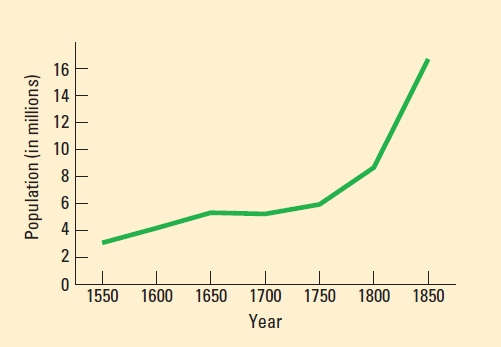Long-Standing Obstacles to Population Growth
Until 1700 the total population of Europe grew slowly much of the time, and it followed an irregular cyclical pattern (Figure 17.1). This cyclical pattern had a great influence on many aspects of social and economic life. The terrible ravages of the Black Death of 1348–1350 caused a sharp drop in population and food prices after 1350 and also created a labor shortage throughout Europe. Some economic historians calculate that for those common people in western Europe who managed to steer clear of warfare and of power struggles within the ruling class, the later Middle Ages was an era of exceptional well-being.
By the mid-sixteenth century much of Europe had returned to its pre-plague population levels. In this buoyant period, farmers brought new land into cultivation and urban settlements grew significantly. But this well-being eroded in the course of the sixteenth century. The second great surge of population growth outstripped the growth of agricultural production after about 1500. There was less food per person, and food prices rose more rapidly than wages, a development intensified by the inflow of precious metals from the Americas (see “Spanish Silver and its Economic Effects” in Chapter 14) and a general, if uneven, European price revolution. The result was a substantial decline in living standards throughout Europe. By 1600 the pressure of population on resources was severe in much of Europe, and widespread poverty was an undeniable reality.

Births and deaths, fertility and mortality, were in a crude but effective balance. The population grew modestly in normal years at a rate of perhaps 0.5 to 1 percent, or enough to double the population in 70 to 140 years. This is, of course, a generalization encompassing many different patterns. In areas such as Russia and colonial New England, where there was a great deal of frontier to be settled, the annual rate of natural increase, not counting immigration, might well have exceeded 1 percent. In a country such as France, where the land had long been densely settled, the rate of increase might have been less than 0.5 percent.
Although population growth of even 1 percent per year seems fairly modest, it will produce a very large increase over a long period: in three hundred years it will result in sixteen times as many people. Yet such significant increases did not occur in agrarian Europe. In certain abnormal years and tragic periods — the Black Death was only the most extreme example — many more people died than were born, and total population fell sharply, even catastrophically. A number of years of modest growth would then be necessary to make up for those who had died in an abnormal year. Such savage increases in deaths occurred periodically in the seventeenth century on a local and regional scale, and these demographic crises combined to check the growth of population until after 1700.
The grim reapers of demographic crisis were famine, epidemic disease, and war. Episodes of famine were inevitable in all eras of premodern Europe, given low crop yields and unpredictable climatic conditions. In the seventeenth century much of Europe experienced unusually cold and wet weather, which produced even more severe harvest failures and food shortages than usual. Contagious diseases, like typhus, smallpox, syphilis, and the ever-recurring bubonic plague, also continued to ravage Europe’s population on a periodic basis. War was another scourge, and its indirect effects were even more harmful than the purposeful killing during military campaigns. Soldiers and camp followers passed all manner of contagious diseases throughout the countryside. Armies requisitioned scarce food supplies and disrupted the agricultural cycle while battles destroyed precious crops, livestock, and farmlands. The Thirty Years’ War (1618–1648) witnessed all possible combinations of distress. The number of inhabitants in the German states alone declined by more than two-thirds in some large areas and by at least one-third almost everywhere else.